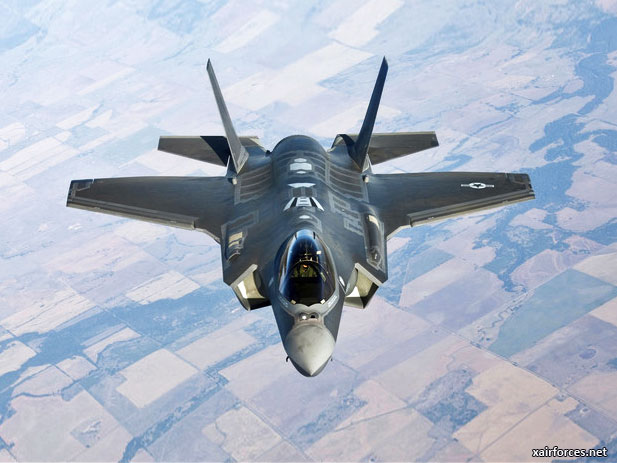
Lockheed Said Close to Pentagon Backing for 29 F-35 Jets

Lockheed Martin Corp. (LMT) is close to winning Pentagon backing to build all 29 F-35 fighters planned for the coming fiscal year after three years of cutbacks in orders for the nation’s costliest weapon, U.S. officials said.
The Pentagon wants to provide stability after postponing orders for 425 planes since February 2010, according to the officials, who asked not to be identified discussing budget deliberations. While the Defense Department’s budget proposal for the year that begins next October isn’t final and some reduction in F-35 funding is still possible, no plan for major cuts is under consideration, the officials said.
Inclusion of funding for all 29 planned F-35s in the budget proposal President Barack Obama is due to submit in February would be the latest show of Pentagon support for the fighter after past criticism. The Defense Department said last week it had reached an “agreement in principle” with the company on a contract valued at as much as $4 billion for the fifth production batch of 32 F-35s. Funding for those planes will come out of money already appropriated.
Previous postponements of planes were based on development setbacks and rising costs for the F-35, now estimated to cost $395.7 billion for 2,443 planes, a 70 percent increase since 2001.
The plane, known as the Joint Strike Fighter, is “a very big growth priority” for Bethesda, Maryland-based Lockheed Martin, the world’s biggest defense contractor, according to Marillyn Hewson, who will become chief executive officer in January.
Lockheed Sales
“It represents a significant part of our revenue today, and it will continue to grow going forward,” Hewson, who is currently president and chief operating officer, said Nov. 29 at an investors’ conference in New York. The F-35 accounted for about 14 percent of Lockheed Martin’s net sales for the nine months ending Sept. 30, according to a company regulatory filing.
Lockheed Martin fell 5 cents to $91.48 at the close in New York trading after rising 13 percent this year.
The Pentagon’s plan for the fiscal 2014 budget doesn’t include the potential effects of sequestration, automatic defense cuts of $500 billion over a decade. Those reductions will start taking effect in January unless Obama and Congress reach a deal to avert the combination of spending cuts and tax increases known as the fiscal cliff.
“We’d have to cut” F-35 procurement by 9.4 percent, the same level of cuts as for research and development, Pentagon Comptroller Robert Hale said at the analyst conference. The effects on the F-35 program would be “minimal,” Bruce Tanner, Lockheed Martin’s chief financial officer, said at the conference hosted by Credit Suisse Group AG.
Past Delays
The Pentagon’s budget plan for the current year, fiscal 2013, delayed the purchase of 179 aircraft, the third consecutive year the Pentagon has reduced its annual request for the fighter from earlier plans.
The number of planes postponed was 124 in February 2011 and 122 in February 2010.
The Pentagon’s current budget plan calls for 29 aircraft in fiscal 2014, rising to 44 in fiscal 2015 and 66 in fiscal 2016.
While Pentagon officials have cited recent signs of progress for the F-35, Air Force Lieutenant General Christopher Bogdan, who at the time was deputy director of the fighter program, said in September that his office’s relationship with Lockheed had deteriorated to “the worst I’ve ever seen.” Bogdan takes over this week as the F-35 program manager.
Short-Term Goals
“Lockheed has seemed to them to be focused on short-term business goals, and we’d like to see them focused more on execution of program and successful delivery of the product,” Frank Kendall, undersecretary of defense for acquisition, told reporters at the Pentagon on Nov. 13, explaining the background to Bogdan’s comments.
Work on the F-35 “is progressing very well,” Hewson said Nov. 12 on a conference call with analysts.
“We are going to meet our commitments this year on delivering the aircraft that we’ve committed to,” she said. “We’ll continue to be very much engaged.”
The F-35 will be “the cornerstone of air dominance” for the U.S. for more than three decades, Deputy Defense Secretary Ashton Carter said today at a retirement ceremony for Vice Admiral David Venlet, who has overseen the fighter program since February 2010.
At that time, the program was progressing technically “but it had some serious problems with execution -- both process discipline and cost discipline,” Carter said. “These issues were leading to an erosion of support here at home, internationally, in Congress and with the taxpayer.”
The F-35 program today “is operating on sound footing, making real progress” and will succeed “with continued careful program management,” Carter said.
Source: By Tony Capaccio / Bloomberg News - 06 December 2012
Photo: Inclusion of funding for all 29 planned F-35s in the budget proposal President Barack Obama is due to submit in February would be the latest show of Pentagon support for the fighter after past criticism. (Photo by Lockheed Martin)
(6.12.2012)
|